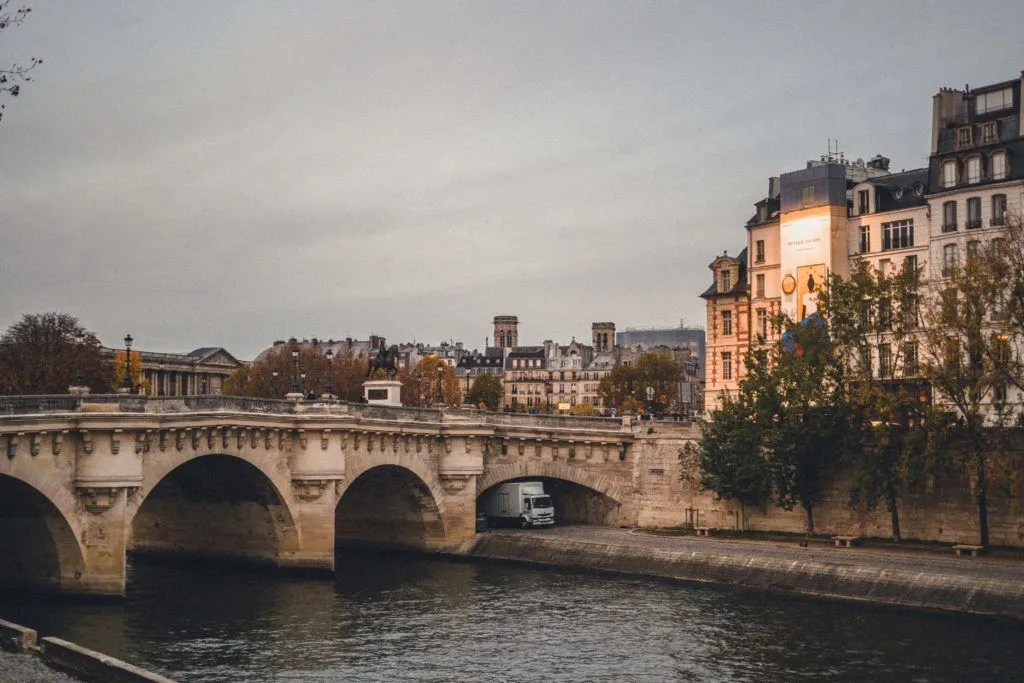Last Updated on 22nd March 2022 by Sophie Nadeau
Quite literally translated into English as ‘New Bridge,’ in spite of what you might think, Pont Neuf is actually the oldest still standing bridge in Paris. Spanning the River Seine and adjoining the right-bank with both the left-bank and the historic Île de la Cité, it’s hard to believe that Pont Neuf has stood in situ since the early 17th-century. Here’s a brief history as well as how to visit!

Contents
Pont Neuf, a bridge dating back to the 17th-century
With its bold arches, allowing Seine River Cruises to pass underneath throughout the day or night, you’ll know you’re at the right bridge when you spy the monument which briefly touches the narrow end of Île de la Cité (i.e. the oldest part of Paris) before connecting both sides of the mainland across the River.
The first time a bridge was considered to be placed at this point of the Seine was under the orders of Henry II in 1550. While the other bridges linking Île de la Cité to the mainland would have been overladen with housing and the like (including the ever-crowded and since demolished Pont Notre-Dame), the new bridge would not have any dwellings constructed on it, making it the first open-air Parisian bridge.
It would also have pavements, meaning that pedestrians would be protected from mud and horse droppings. However, for various reasons, the construction of Pont Neuf was not undertaken until several decades later, when the first stone was laid during the reign of Henry III in 1578.
After a major change in architectural plans, not to mention the Wars of Religion, the construction of Pont Neuf went pretty slowly! Truth be told, the bridge wasn’t actually finished until July of 1606 before being officially inaugurated the following year, in 1607.

While seven stone arches link the right bank to Île de la Cité, just five link the rest of the bridge from the left bank to the Seine Island (the largest of three islands in the river). Though the bridge may be a beautiful attraction and frequented by all ages today, during the 18th-century the Parisian location was most associated with crime.
You see, it was not uncommon for gangs to hide out around the area, robbing people who wished to cross to the other side of the river. At one point, Pont Neuf even had its own gallows, though with more crowds came more entertainers too.
As well as being a crime hotspot (including many a pickpocket), the bridge was filled with entertainers such as acrobats, fire eaters, and the like. In total, the bridge spans a length of just over three-hundred metres and its crown jewel is undoubtedly the Equestrian statue of Henry IV.
Standing in pride of place and surrounded by stone benches where you can sit and rest while enjoying views towards the West of Paris (i.e. in the direction of the Eiffel Tower), the bronze statue is reminiscent of an ode to the French King which was created between 1614 and 1618.
As with many such statues, the monument was destroyed during the French Revolution and was only recreated in 1818 during the restoration of the Bourbon monarchy.
Since 1889, the bridge has been listed as a historic French monument on account of the fact that, while all of the other old bridges in the area were demolished in favour of more modern editions, Pont Neuf remains to this day.

Things to see and do near Pont Neuf
Thanks to its incredibly central position in the very heart of Paris (i.e. quite literally in the 1st arrondissement), a stroll across to either side of Pont Neuf undoubtedly givers wanderers the chance to see many of the major Parisian monuments (not to mention some of the oldest) up close.
Louvre Museum
Situated just a short stroll from Pont Neuf, the Louvre Museum is the largest museum in the world and is set against the backdrop of medieval fortifications turned Royal Palace. Housing treasures such as the Winged Victory of Samothrace and the Mona Lisa, check out my complete guide to visiting the Louvre (and everything you should know before you go!)

Square du Vert-Galant
Situated directly below Pont Neuf, the pretty Parisian park of Square du Vert-Galant was actually derived from the quays which were needed to anchor the stone bridge in place. Named ‘green gallant’ for Henry IV, the space is perfect for a picnic during the summer months. My girlfriends and I often joke that the weeping willow which presides over the park is the ‘perfect spot for a first kiss’.

Enjoyed reading about Pont Neuf? Pin this article now, read it again later:

